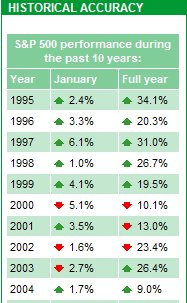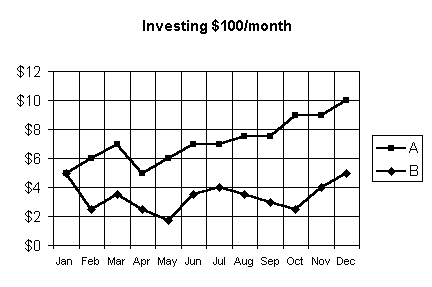Those of us who are feeling queasy about the latest market swings and bummed about the ongoing downward movement of our investments are looking for some consolation. We may have already seen the effects of bailouts, government stimulus checks and rate cuts on our economy and it’s still unclear if these are enough to offset the loss of consumer confidence and the weight of debt fears that are troubling the markets.
But wait! Even if the stock market does decide to disagree with us and take a nosedive this year, we need to decide whether the fundamentals are still in place. We may want to ask ourselves if there’s a lovely silver lining in all of this, and if we have faith in what certain pundits say — that the stock market’s long term trend is UP. For every negative voice you hear, there are also those who try to stay optimistic. If you have long term goals, then you may want to reenforce your commitment to those goals (even though it seems tough to do right now). Let’s make the case for buying into market dips.
Why A Bad Market or Down Years Can Be Great For Investors

There are a couple of good things about down markets; for example, you may think of slumps as a way for markets to shake out the “excess”, to normalize and to restore its health so that it doesn’t get too far ahead too fast (like it did in the late 1990’s). In some ways you can also look at it as part of the natural course of things and that cycles come and go. But what’s really fantastic about this is the opportunity it presents.
Now is your chance to buy low. And keep buying low.
But as a caveat, remember that what it IS that you are buying low also matters quite a bit. Purchasing something purely because of its low price can turn out to be a stupid move, as I learned a long time ago.
At any rate, let’s go back to why contrarian investing can be a good thing. What may not be immediately apparent (as is the case with many things we learn about stock market behavior) is that those of us who have been dollar cost averaging should probably be smiling from ear to ear because the market volatility is actually doing us a service. So how about an illustration or two to prove this claim?
Example 1
Here is an amazing example from ElderAdo Financial that can bring the point home.
In the figure below, we explain how effective dollar cost averaging works. For example, there are two investors, investor A and investor B. They both buy a mutual fund initially priced at $5 per share. They each invest $100 per month into their respective fund regardless of what happens to the fund price. The mutual fund that investor A buys generally grows over the year and ends at $10 per share. The mutual fund that investor B buys, however, drops and stays low for the entire year and finally ends up at $5 per share.

Which investment will provide the better return?
The accompanying explanation for this example is as follows:
“If we add up all the shares investor A bought through the year we end up with 173 shares. To get the ending value of investor A, we multiply the number of shares (173) by the ending price ($10 per share) to get an ending value of $1730. To get the ending value of investor B we multiply the number of shares (410) by the ending price ($5 per share) to get an ending value of $2050.
So investor B ended up better!
Initially looking at the graph, you would assume that investor A had a better investment than investor B, but you would be wrong! Why did investor B do better? Because when you are dollar cost averaging you are buying the same dollar amount each month, but you buy more SHARES when the stock price drops. Look at the month of May for investor B; he bought 66 shares compared to only 17 shares for investor A.
Investor B ended up with more than twice the number of shares than investor A because the fund price stayed low throughout the year, thus purchasing more shares each month.”
Cool, eh?
Please note that this example applies strictly to two investors who are both dollar cost averaging. The answer to the question of “who does better” completely changes when these same investors instead invest all their money in the beginning of the time period as lump sum amounts. In that case, investor A would double his money while investor B will simply break even by the end of the given timeframe. Nevertheless, there’s a place for both styles of investing in anyone’s repertoire of investment strategies.
Example 2
If you want to be further convinced about how well dollar cost averaging works for you in a down market, here are even more examples from About.com demonstrating this phenomenon. These illustrations prove that you’ll actually make more money if you invest throughout the course of a down market that eventually recovers, than if you invest regularly during a market that instead, grows steadily (again, results are different from lump sum investing, which will favor consistently upward trending markets):
Let’s say you begin investing when shares are at $20 each. If the market grows upwards at a steady pace and reaches a target price of $44.43 by the end of the year, and you invest $1000 a quarter for 12 years, you’ll get this result:
Steady Growth
Shares Owned: 1,655
Portfolio Value: $73,544
If instead the shares start at $20 each, then gradually dip down to a low of $12.67 each after a few months, then work its way back up to $44.43 by year’s end, then your $1000 quarterly investments over a 12 year period will look like this:
Down Market With Recovery
Shares Owned: 2,427
Portfolio Value: $107,809
Moral of the story: more money in the end when we experience a down market, provided we invest through it!
As we can see here, dollar cost averaging is built to make you sleep at night, despite your fluctuating portfolio numbers and lurching fund account levels. Plus, you’ll actually come out ahead if the market slides while you diligently and consistently apply this approach. If you’re like me and decide to employ this strategy (especially if you’re investing in employee retirement accounts), you’ll find that you’ll tend to shrug off or even welcome dips in the market that come every so often.
Image Credit: bigcharts.marketwatch.com
Copyright © 2008 The Digerati Life. All Rights Reserved.

{ 11 comments… read them below or add one }
Thank you for reminding me of this…I guess I should be glad to be buying low.
Trying to predict and time the market I see. Well I think if it were truly possible, efficient market forces would have corrected the arbitrage opportunity.
Invest for the long term I say, and continuously average down – and keep your eyes on the long term horizon prize – that’s my investing opinion.
Nice article. I personally love this kind of market. You can dip into quality companies that are heavily oversold on a short-term basis and usually sell after a few recovery days for a nice profit, or you can use this as an opportunity to buy quality companies at knockdown prices, and tuck them away for a few years.
Just look at Tesco as an example (the UK’s leading supermarket and a Buffett shareholding)currently trading at around 395p. Showing weakness in the short-term, but long-term it should be a lot higher.
What do you think will be best approach to investing 6 months down the road (around July 2008) in relations to your article.
I have a specific amount which I’ll be putting in the stock market (have some more for other investment options). Will it be best to put all the money in the market at once (let’s say 20 000) or will be best to start with 10 000 and continue investing each month for the rest 6 months of the year (so around 1650 ea month for 6 more months).,
Or it all depends if the market continues to fluctuate or starts going up (with economy outcome looking better) at around that time?
Just curious what your opinion(s) on this sitution is.
DCA is a great tool and it gets a lot of mileage in the media. But, it’s worth noting that there are other similar methods that actually outperform. For an example, see this link for a post about Value Averaging.
I like the charts.
It looks as though dollar cost averaging may be the safest route to go, but it certainly isn’t the way to generate the highest possible returns. I think I will definitely use this approach for investing in index funds and other types of investment vehicles where the ability to predict market performance is a little sketchier and they have a historical trend that is generally up. However, if I ever dabble in individual stocks I may try to do some “timing” of stocks in a limited fashion (i.e. buy stocks when they are relatively low, sell when relatively high). I have learned a lot from Kenny Rogers. “You got to know when to hold ’em, know when to fold ’em…“
This is great for people who are just starting to invest. For people who have been investing a while, most of their money is already in the market. That old money does better when the market goes up. Still, if it’s not yet time for you to start withdrawing, it’s nice to know that your next investments are going to be cheap.
It depends. Down markets are good for someone who is still accumulating. Every buyer loves a sale, right! However, if you are in the harvesting phase of your investing career, the down markets are not good. Hopefully everyone practices good asset allocation and rebalancing strategies so this does not become an issue during their retirement years.
@Arohan,
That’s a pretty good point actually. Glad you brought it up — people who are at the point in their lives who are living off their investments and savings will definitely have a tougher time during downward cycles. So you are absolutely right that when the time comes, we need to rework our portfolios towards more conservative allocations in order to readjust our risk profile accordingly. Downward markets are indeed a prominent risk for those investors who rely solely on their investments to support them.
I thought hard about this and have determined that the strategy I will take now and going forward is to hedge by making sure I develop cash flow and alternative income streams via businesses and projects. In this way, even without a steady job, I hope to always have something beyond investments to tide me and my family over.
DCA only works well when you think the market is headed down, or if you’re investing in highly volatile securities. If either of these is a case, then DCA is a great tool to lower risk and improve.
But if you’re investing in less risky areas during an up market, then DCA will actually harm your returns. Like anything else, DCA is a good tool, but you shouldn’t make it an automatic rule to use it.
@Llama Money,
Excellent points! I did point out that if you are in a consistently rising market, then lump sum investing is superior to DCA. But given today’s circumstances, DCA or VCA (value cost averaging) is a great strategy to execute at the moment.